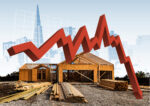Construction costs in San Francisco are still on the rise, but the increase fell behind the national average in the third quarter of this year for the first time since 2021, according to new research by construction consulting firm Rider Levett Bucknall.
The U.S. quarterly national average increase in construction cost is approximately 1.07 percent, and 4.91 percent year-over-year, the lowest increase in three years as inflationary pressures decrease and pandemic-era supply chain issues fade. San Francisco’s average construction cost increases fell behind even those lower national figures at just 0.71 percent in the third quarter and 4.06 percent year-over-year, one of the smallest increases in the 12-city survey. Chicago saw the biggest increase at 6.73 percent, year-over-year, and Phoenix had the lowest at 3.88 percent.
Though the numbers only took San Francisco data into account, RLB associate principal James Casey said the trend is likely similar throughout the Bay Area, as the same companies are bidding on jobs throughout the region.
“If San Francisco construction is booming and escalation is high, then we would expect say San Jose and Oakland to also experience cost escalation as they’re sharing the same pool of contractors, subcontractors and suppliers,” he said.
Construction has decidedly not been booming, with a separate RLB survey showing that San Francisco has just six cranes up in the city this quarter, compared to 33 in the first quarter of 2020. Several apartment projects are wrapping up and the Southeast Treatment Plant infrastructure project in Bayview-Hunters Point dropped from four cranes to two, according to that survey, while new cranes have appeared at residential projects within the Transbay Block 2 and Potrero Power Station projects.
Casey said RLB can’t speculate too much on whether or not a slowdown in construction costs will spur new development, but that it’s reasonable to assume less price volatility would encourage private developers to have more confidence in their ROI calculations, thus encouraging them to get off the sidelines. But considerations such as high land costs and a long entitlement and permitting process may impact these decisions more than building costs, he said.
Plus, even with increases slowing, Bay Area construction costs are still among the highest in the country. RLB data shows a range of $440 to $750 per square foot for prime office space, $560 to $920 per square foot for five-star hotels, $330 to $550 for single-family and $400 to $625 per square foot for multifamily. Only New York City and Honolulu surpassed some, but not all, of those figures.
“Given San Francisco’s high construction cost, a lower percentage here can still represent a much higher cost increase than other cities that have a lower initial construction cost base,” Casey said.
At a recent Marcus & Millichap multifamily forum, apartment developers noted that they haven’t seen much of a drop in construction costs, but “closer to flat feels really good” after the run-up during the pandemic, according to Marco Vakili, managing director of rental developer Alliance Residential.
Developers also noted that subcontractors have recently become more available due to the drop in active projects, which has sped up construction time and led to higher-quality work. Vakili advised those able to move forward with projects to take advantage of this limited period of labor availability.
“Where we are in the market now, with subs leaning in and wanting to get jobs on their boards, that window will close quickly,” he said.
Read more



